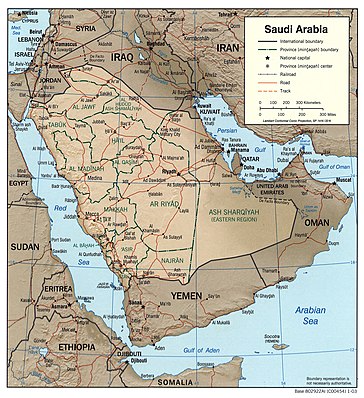
Back تاريخ السعودية Arabic Historia d'Arabia Saudita AST Səudiyyə Ərəbistanı tarixi Azerbaijani Сәғүд Ғәрәбстаны тарихы Bashkir Гісторыя Саудаўскай Аравіі Byelorussian সৌদি আরবের ইতিহাস Bengali/Bangla Història de l'Aràbia Saudita Catalan Dějiny Saúdské Arábie Czech Saudi-Arabiens historie Danish Geschichte Saudi-Arabiens German
The history of of Saudi Arabia as a nation state began with the Al Saud dynasty in 1727.[1][2]
The territory that is modern Saudi Arabia was the site of several ancient cultures and civilizations. The prehistory of Saudi Arabia shows some of the earliest traces of human activity in the world.[3]
It was founded in the area of Nejd, the central part of the Arabian Peninsula. The Sa'udi emirate's leadership is a traditional form of rule on Arabia since the 18th century. Over the next century and a half the family went through a lot of opposition and hurdles. The family faced opposition from powerful families of Arabia but also rulers of Egypt and the Ottoman Empire.[4]

In 1902 Abdul Aziz Ibn Saud, also known as Abdul Aziz Al-Saud, took over the city of Riyadh from another family named Al-Rashid.[5] He continued to win more areas, and on 8 January 1926, he became the King of Hejaz and the Sultan of Nejd.[6] On 20 May in 1927, the government of the United Kingdom accepted him as the King of those areas ruled by him (the Nejd and Hejaz).[6] His kingdom now became a sovereignty. The modern nation state of Saudi Arabia was established in 1932 as 'the Kingdom of Saudi Arabia' declared by King Abdul-Aziz Al-Saud.[5] Petroleum oil was found in Saudi Arabia on 3 March in 1938, which made the country rich since the export of oil started to bring in a lot of money.[7]
But the history of the Arabian Peninsula contains more history, which led to the development of the Saudi state. Inhabitants and cultures can be traced back 63,000 years ago.[8] The most significant event that happened in the Peninsula is the rise of the Islamic religion presented by Prophet Muhammad. The Rashidun Caliphate, Umayyad Caliphate, Abbasid Caliphate and Fatimid Caliphate all occupied the Arabian Peninsula and thus helped it develop to how we know it today. More dynasties were there in history, but the Islamic holy cities of Mecca and Medina were under the protection of the Hashemite Sharifs of Mecca from the 10th century onwards.[9][10]
- ↑ "Saudi Arabia to commemorate 'Founding Day' on Feb. 22 annually: Royal order". Al Arabiya English. 27 January 2022. Archived from the original on 1 October 2022. Retrieved 15 February 2022.
- ↑ "History of the Kingdom | kingdom of Saudi Arabia – Ministry of Foreign Affairs". www.mofa.gov.sa. Archived from the original on 2 March 2022. Retrieved 15 February 2022.
- ↑ 88,000-Year-Old Finger Bone Pushes Back Human Migration Dates, www.nationalgeographic.com
- ↑ Almogren, Nawaf Bin Ayyaf(Nawaf Bin Abdulaziz Bin Ayyaf) (2020). Diriyah narrated by its built environment : the story of the first Saudi State (1744-1818) (Thesis thesis). Massachusetts Institute of Technology. hdl:1721.1/127856.
- ↑ 5.0 5.1 Cite error: The named reference
:0was used but no text was provided for refs named (see the help page). - ↑ 6.0 6.1 Al Kahtani, Mohammad Zaid (December 2004). The Foreign Policy of King Abdulaziz. University of Leeds.
- ↑ Society, National Geographic (11 March 2021). "Oil Discovered in Saudi Arabia". National Geographic Society. Retrieved 4 May 2022.
- ↑ Cite error: The named reference
:7was used but no text was provided for refs named (see the help page). - ↑ Cite error: The named reference
:4was used but no text was provided for refs named (see the help page). - ↑ Cite error: The named reference
:5was used but no text was provided for refs named (see the help page).